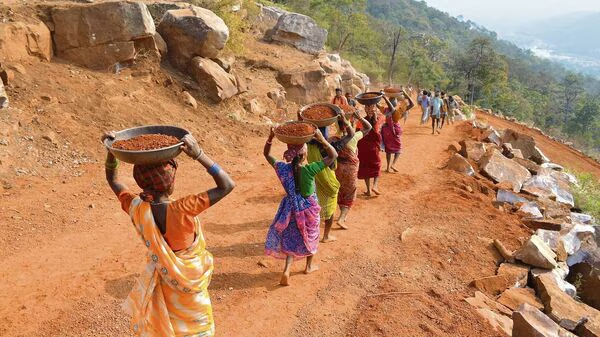Flooding in weather models boosts soybeans

New Delhi: Government officials are considering using excess rice stocks for part-payment under the MGNREGS amidst swelling granaries and rural distress. The proposal, aimed at easing economic pressures ahead of upcoming state elections, awaits final decisions. Measures to curb inflation and increase domestic rice availability have resulted in a surplus of 14 million tonnes. Discussions include distributing rice alongside wages, potentially impacting rural wage rates varying from ₹234-374/day. The government also explores selling rice through OMSS, discontinuing e-auctions to manage market prices.
New Delhi: Swelling granaries and rising rural distress may prompt the government to give away rice as part-payment for workers under the national job guarantee scheme, two officials aware of the plans said.
The food department under the consumer affairs ministry has requested the rural development ministry to consider utilizing excess rice for part-payment of wages, two officials aware of the plan said. “A proposal on the same has been given to the rural development ministry. Discussions are still going on, and the government is yet to take a call,” one of the two officials said on condition of anonymity.
Also read | Spending on rural job guarantee scheme MGNREGS overshoots FY24 estimates by 23%
The Mahatma Gandhi National Rural Employment Guarantee Scheme (MGNREGS) promises 100 days of paid work in a year to households whose adult members volunteer for unskilled manual work. The latest plan comes ahead of assembly elections in Haryana, Maharashtra, Jharkhand, Jammu and Kashmir.
Amid a series of measures The Centre took a series of measures last year curb price rise and increase domestic availability of rice, including an exports ban on non-basmati rice in July, 20% export duty on parboiled rice, and a floor price for basmati rice exports in August. The well-intentioned measures, though, have led to a surplus rice stock 14 mt tonnes, raising warehousing costs.
“Food for work programme—allocation of rice through the rural development ministry for payment of wages under MGNREGS—which is one of the options to dispose of our surplus rice, is being explored,” the official cited earlier said.
When asked about whether the rice distribution will be on top of MGNREGS wages, the official said, “We can give it as part of their wages. Instead of giving the full value of their labour wage for the day, we can give some quantity of rice. For example, if they work for seven days in a week, rice can be given as their wage for some days. That is the kind of thing that can be worked out. Details will be worked out once the decision is made. This is one of the options; there could be various combinations. The wage for one day will definitely be more than ₹200-300. One kilo could be given for one day and the rest will be paid in cash.”
The job guarantee scheme recorded 305.2 crore person days in FY24, up from 293.7 crore in FY23, indicating ongoing rural distress and a lack of job opportunities in cities. This indicates ongoing rural distress, an issue that has also been echoed by major FMCG firms.
Varying wage rates The MGNREGS wage rate varies from one state to another, ranging from ₹234-374 per day. Rural wage rates over the last decade have been consistently lower compared to the previous decade. Despite food inflation being recorded at around 10% in December and remaining over 5-6% over the last few years, rural wage rates have not increased correspondingly.
Mint had earlier reported that the government was exploring options, including the allocation of rice under Pradhan Mantri Garib Kalyan Yojana, giving free food to employees of MGNREGS and reducing the price of rice under OMSS operations to dispose of rice sitting in godowns.
The Parliament passed NREGA in August 2005, which came into force on 2 February 2006. On 2 October, 2009, it was renamed MGNREGA.
Queries sent to secretaries and spokespeople of the departments of expenditure, rural development, and consumer affairs remained unanswered till press time.
The government may also sell rice to states and union territories, without requiring them to participate in e-auction under the open market sales scheme (OMSS). The e-auctions were discontinued as an anti-inflation measure on 13 June last year, barring north-eastern and hilly states and those facing law and order situation and natural calamities, the second official said.
“If it is at all done, I think it will have marginal importance in the sense that even if rice is given, it will only go into the market. If it is an excess demand for rice, I don’t think it will help much. What is needed is to expedite exports of rice. I don’t think at the end of it, it will have any financial implication because the payment is made in cash; in terms of rice, it will have a financial value,” said D.K. Srivastava, chief policy advisor at Ernst and Young and member of the advisory council to the 15th Finance Commission.
For states’ own schemes State governments and UTs were allowed to purchase rice from the Food Corp. of India (FCI) for their own schemes at the specific price fixed for the provision under the OMSS at ₹3,400 per quintal for FY24 and ₹2,000 per quintal for FY23.
OMSS refers to the sale of wheat and rice in the open market at prices fixed by the consumer affairs ministry through e-auction to control the price in the market by providing foodgrains at reduced prices to curb inflation. Under the Scheme, the government, through its apex body FCI, offers wheat to processors and flour millers through e-auction. Between June 2023 and February 2024, the government sold 187,000 tonnes of rice under OMSS, against 2.5 million tonnes last August and 500,000 tonnes in June 2023.
The estimated rice procurement by the government for the April 2024 to March 2025 period is 52 mt. The Centre has 40.8 mt of rice for allocation and distribution under the National Food Security Act, welfare schemes and other schemes for FY25, excluding the opening balance of 30.2 mt as of 1 April 2024 against the norm of 13.6 mt. The closing stock is estimated to be 41.4 mt as of 31 March. After ensuring these two, the government has 27.8 mt of rice for market interventions or OMSS.















